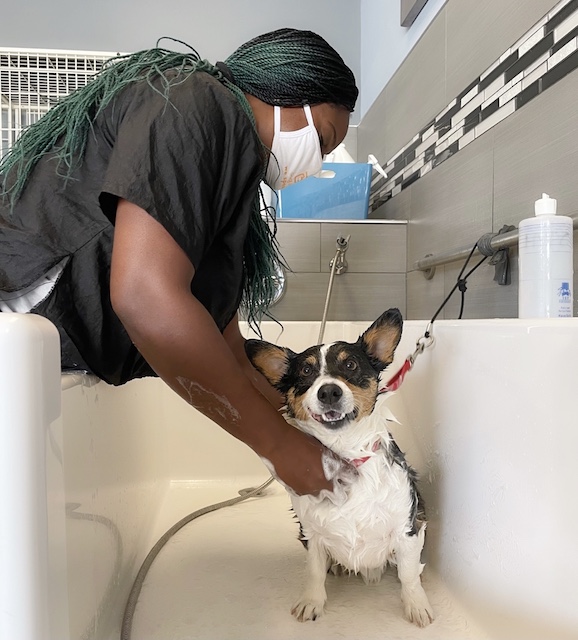There are a number of reasons why our pets scratch away at their fur and skin. If you’re a new or seasoned dog or cat loving family questions inevitably come up especially when the itchiness becomes excessive. A lot of thing cross our minds when we see our pets scratch away. Is it environmental allergies? Food allergies? Can it be from stress? How do we know?

I recently had the chance to take Harley for his seasonal grooming at Dogtopia at Bloor West Village and met with Jennie Tait for the launch of The Empathy for Itch Campaign – a joint initiative between the Canadian Academy of Veterinary Dermatology (CAVD), CEVA Animal Health, Zoetis and Royal Canin Canada. The goal of this initiative is to educated and encourage pet owners to think about their pet’s skin health more often.
At the visit I was able to ask a lot of questions as a first time dog owner. I thought it would also be useful information for others seeing as many have added pups to their homes during the pandemic — it’s an ideal time to learn!
“Pet owners need to know the importance of keeping an eye of their pet’s skin health since pruritus, or itching, can also be due to an underlying health issue that could run more than just skin deep,” says Tait AHT, RVT, Charter Member VTS (Dermatology) and Executive Committee Member of the CAVD. “Excessive licking, chewing, biting, scratching, and rubbing are all forms of itching, and a sign that a pet has a skin issue. While some itching is normal in our furry friends, excessive itching, hair loss, pink skin, darkened skin, and even rust-coloured areas of hair, can all indicate that it is time to make an appointment to check their skin, coat, and ears. I can’t say it any easier – itchy pet? See your vet.”
According to recent studies, 3.9 million Canadians have adopted, purchased or fostered a cat or dog within the last year. What surprised me was to learn that 1 in 5 Canadian pets are currently suffering with skin issues that require vet attention.

What should we look out for?
Excessive licking or scratching: can be from allergens in the environment but we also learned that many dogs also lick and scratch themselves when they are bored or stressed. And of course, they can also be caused by flea or tick bites.
Scaling skin (or dandruff): Some breeds are prone to scaling skin and there are many reasons they are caused from environmental to nutrition. They may appear like dandruff or in sheets. Some of the symptoms to look out for is excessive shedding, greasy or dry accumulation of surface cells, unusual odour, sometimes secretion of pus.
Staining between toes: usually a result from excess licking. Also, pay attention to any unusual odours, as well as greasy skin or coat.
Hot Spots: inflamed and infected spots that can appear reddish, irritated, moist and sometimes oozing. A common skin issue that can be treated but if you don’t pay attention they can spread, grow and cause more irritation. Commonly occur in hot and humid climates and can be triggered by environmental causes (trees, weeds, etc) but can also occur with excess moisture in the coat from swimming or bathing. Sometimes they are reoccurring.
Scooting: it may be funny to see but a pet dragging their butt across the carpet or grass is a sure sign of some discomfort. It could be itchy or even painful. Dogs that get groomed often may be irritated by perfumey grooming products. Another concern is clogged anal sacs so you’ll want to check with your vet to determine causes.
Excessive bathing: we may be inclined to give our pets baths often but in actually fact for most breeds it isn’t always a good idea. We give Harley a good bath at the spaw every three or four months. Unless it’s absolutely necessary like coming home from playing in the mud or if he had a chance to roll in dead fish or raccoon poop. Argh.

When should you take your pet to see the Vet?
Skin health is often overlooked in pets, and when it comes to skin conditions (particularly itchy skin), the path to relief is not a one-size-fits all solution.
If you notice these signs or anything else that seem out of character for your pet it’s best to call your Vet ASAP. Take note of the type of food and treats your pup eats and take photos when possible. We’ve found this useful even before pandemic times to help with initial assessment over the phone or video call.
The good news is once identified, most issues can be managed through a combination of the right diet, medication, and topical solutions, giving the pet back the comfort and wellbeing.


